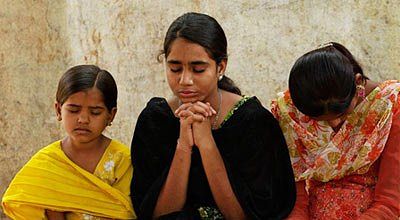Woman’s Rape, Death Spark Global Conversation on Condition of Indian Women
The brutal rape and ultimate death of an unnamed woman in New Delhi, India, this week has opened the eyes of the world to violence against women in India and their deeply rooted social plight.
“The long-time abuse women in India endure has now been highlighted,” said K. P. Yohannan, president of Gospel for Asia (GFA). “Their social stigma and inhuman treatment with impunity make them the one of the largest unreached people groups.”
Gospel for Asia specializes in ministering to them through its “Women Reaching Women” outreach in India. Women missionaries are working heavily in rural areas where unlawful abuse occurs regularly without retribution and in urban prostitution centers.
Conditions are worst among the women “untouchables,” or Dalits, who are the lowest castes and considered subhuman. Of India’s 1.2 billion people, one-fourth are “untouchables.”
The ratio of 1,000 men to 850 women is owing to routine murders of women through infanticide, gender-based abortion, the dowry system and lack of proper medical care. Mortality rates of Indian women in childbirth are 254 per 100,000 women, contrasted with only 21 in the United States.
Yohannan calls the conditions for women in India “a horrendous evil that is worsening.” Of all married Indian women, 46 percent are age 18 or under. Marriage of girls age five to seven, although illegal, is still practiced in some rural areas. Approximately 10,000 women are murdered annually when they cannot raise the required dowries for marriage.
An estimated one in four rapes in India takes place in Delhi, now dubbed “the rape capital of India.” A high percentage of these are by family members. The most recent statistic on record of 21,000 rapes in 2008 has risen dramatically, with many authorities estimating as few as one percent of all rapes reported, according to Yohannan.
Once a woman has been raped, she is socially outcast from marriage forever, and the family bears lasting shame.
“I am grateful for how the Prime Minister and Sonia Gandhi, along with government agencies, are responding to this outcry. Positive steps are being taken.”
“Education for women in the name of Jesus is bringing hope,” said Yohannan. Indian women, who are often the last allowed to eat and the first to be kept illiterate, are learning to read and write and being educated on their human rights.
More than 59,000 women in India are enrolled in the microfinance system administered by GFA female partners. Women learn to support themselves and their families through gift supplies, such as sewing machines or chickens, from GFA donors.
Outcast widows are receiving aid directly from GFA’s “Women Reaching Women” female partners. Annually, 46,000 widows in India are murdered or turned out of their homes.
“Women Reaching Women” is also educating children of urban prostitutes to break the cycle of following in their mothers’ steps. GFA’s 580 additional Bridge of Hope institutions are bringing education, meals and healthcare to 60,000 children in India.
“While India needs enforcement of stricter laws to protect women, ultimate liberation and hope come only through the love of Christ,” said Yohannan. “In teaching, we are showing women that Jesus cares about their needs, loves them and answers their prayers.”














































